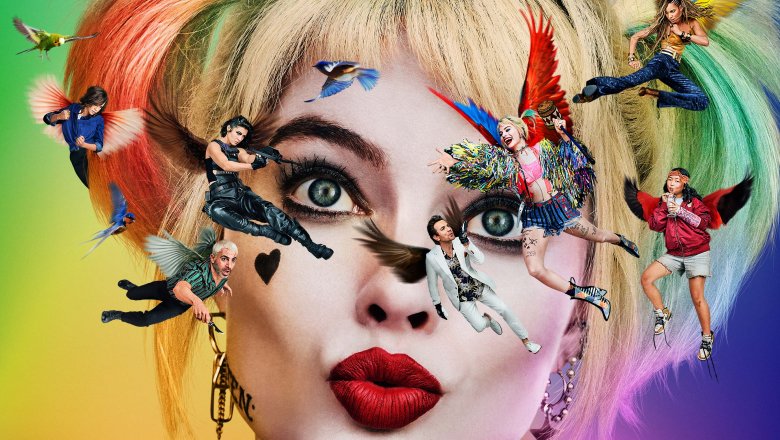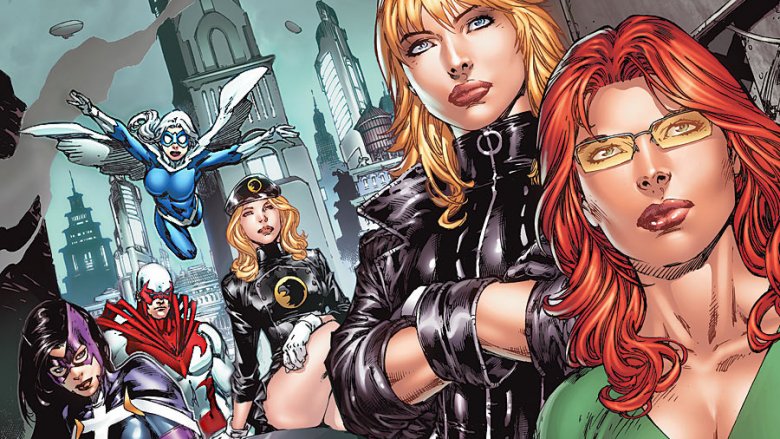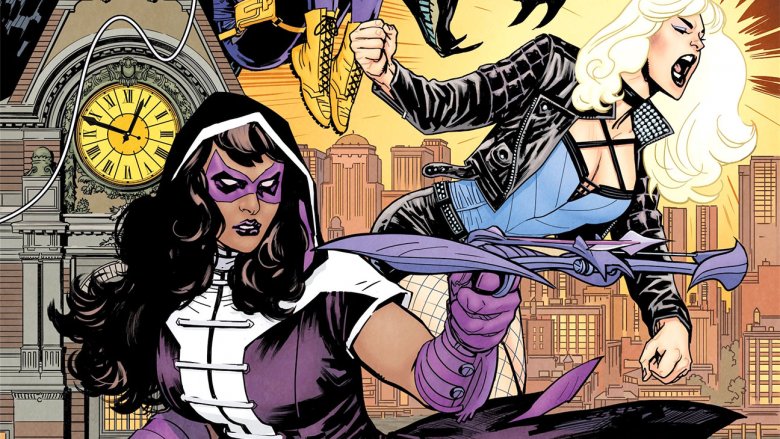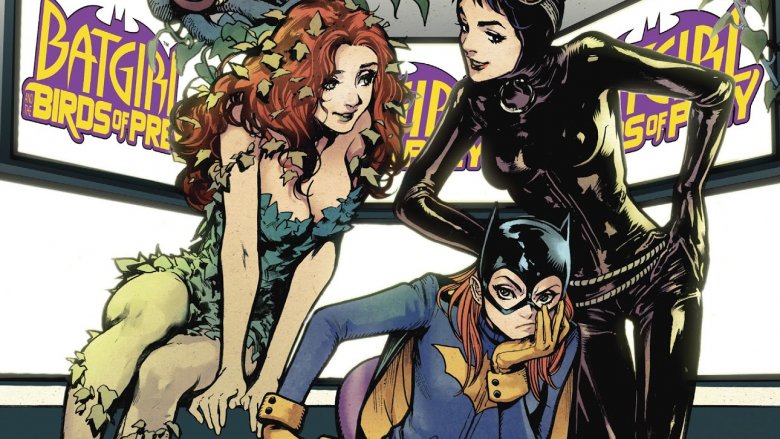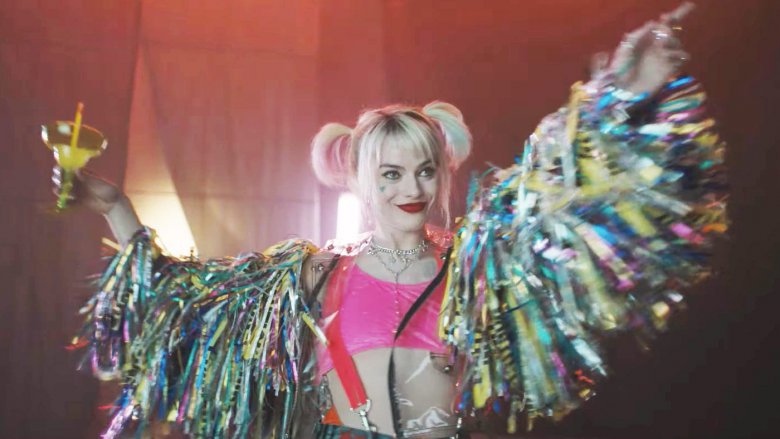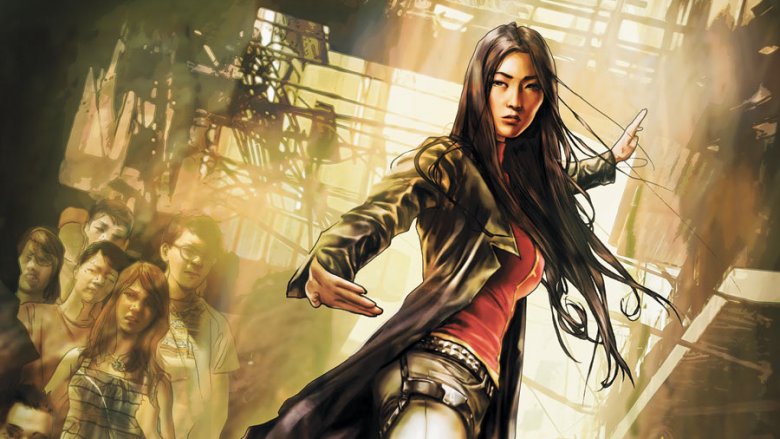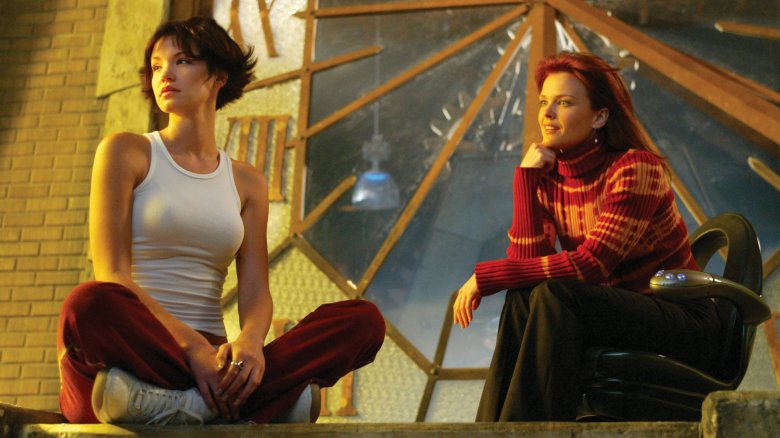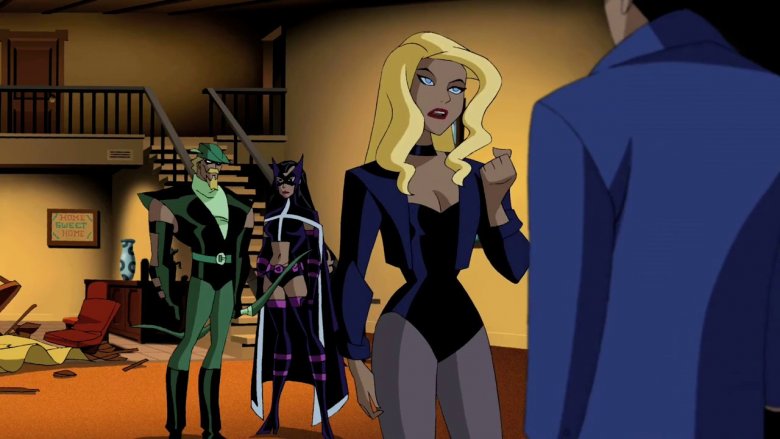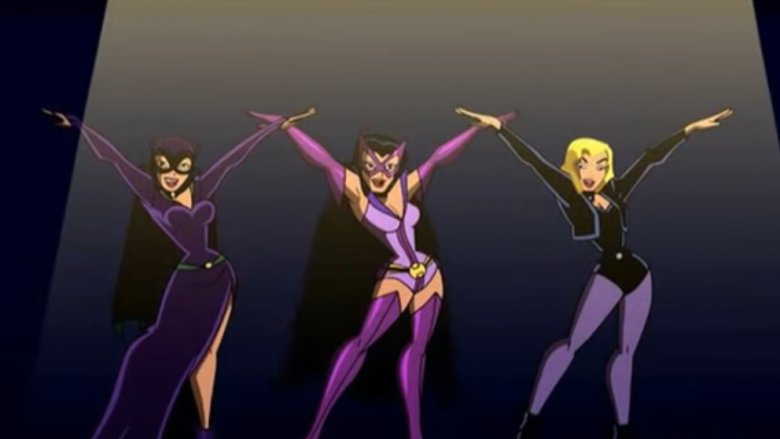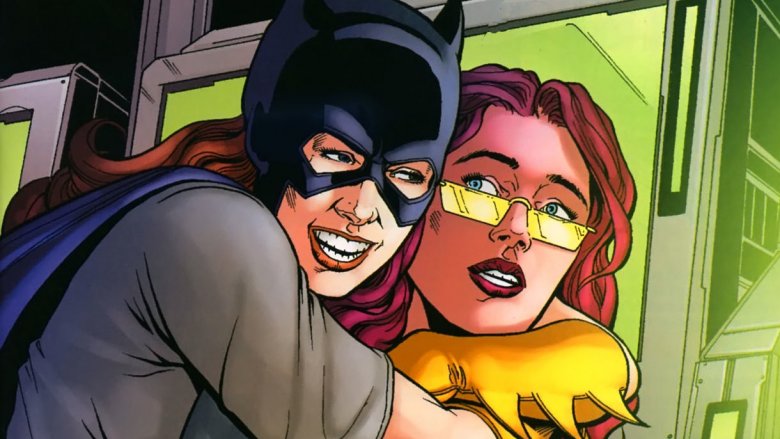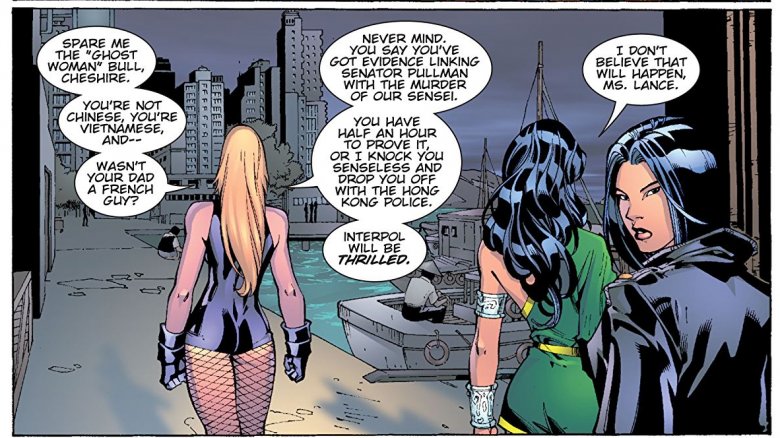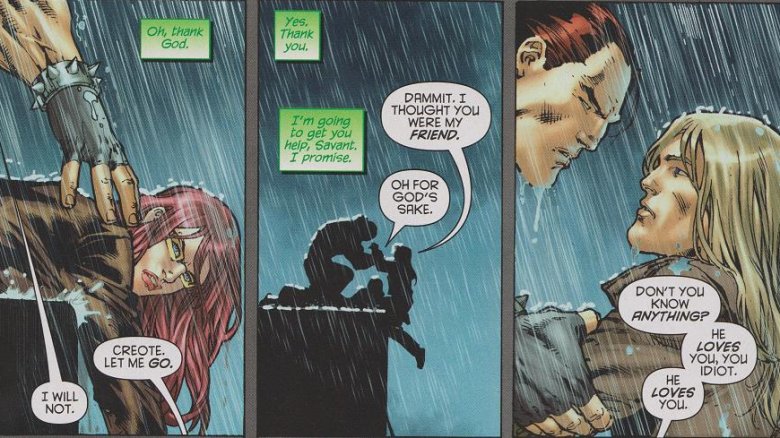The Untold Truth Of Birds Of Prey
Birds of Prey (and the Fantabulous Emancipation of One Harley Quinn) lobs a cherrybomb into the Kevlar-clad, teeth-gritted world of superhero movies, leaving the screen a neon mess of smeared lipstick, crossbow bolts, and gold leggings. The Joker? Old news. Make way for the new Clown Princess of Crime in Harley Quinn — no longer Daddy's Lil Monster, as her iconic T-shirt proclaimed in Suicide Squad. She's no one's anything anymore, save the leader of the baddest girl gang to ever hit the Gotham alleyways. She's fierce, she's fabulous, and alongside the Birds of Prey, she takes no prisoners.
But who exactly are the Birds of Prey? And what do they have to do with Harley Quinn? Well, the Birds of Prey have been a lively part of the DC Comics landscape since 1996. But the Birds as they've existed on the page are rather different than the ones of the silver screen. So who's part of the team, and what superheroic daring-do have they historically gotten up to? Join us as we explore DC's number one squad, from their origin story to their ever-changing lineup.
The Birds of Prey are pretty young for a superteam
From the Justice League to the Fantastic Four, superpowered team-ups have been part of the genre for decades. Sometimes they headline in pairs, a la Batman and Superman in DC's long-running World's Finest title. Oftentimes, they're sprawling collections of aliens, shapeshifters, super-soldiers, and psychics, as in the Avengers. Occasionally, they're a grab bag of misfits, such as the Suicide Squad, the Outsiders, and the Doom Patrol. Generally speaking, most of these groups have been around for a while, to the point of being adapted to other mediums — sometimes more than once.
The Birds of Prey, in contrast, are a fairly new invention. Born in 1996, in the Chuck Dixon and Gary Frank one-shot Black Canary/Oracle: Birds of Prey, the team didn't get their own book until 1999. That run of comics, largely defined by writers Dixon and Gail Simone, continued until 2009. Numerous reboots have flourished and floundered, the most recent being Batgirl and the Birds of Prey, which debuted in 2016 as part of DC's Rebirth event, but it was cancelled in May 2018. Despite this current absence of the team, the Birds of Prey are still regarded as a major player on the DC stage, a designation made ironclad by the Birds of Prey movie, however removed it might be from its comics origins. Sure, the Birds are young compared to the Justice League, but that doesn't mean they haven't made a comparable splash.
Pretty much no one ever calls them by their team name
As far as superhero names go, "Birds of Prey" is pretty great. It implies the team's majority-to-all-female lineup without being condescending. It stands out when compared to other DC team names. It denotes the approach of the Birds themselves to the criminals they pursue — that of hunters, confident in their ability to track, trap, and capture their quarry. In a genre littered with twee, saccharine, or off-puttingly seductive monikers for its heroines and their organizations, "Birds of Prey" is a stand-out winner.
Readers will not, however, find the name very often within the comic's own pages. It wasn't until issue #86, published a full six years after the series' inception, that anyone on the titular team actually spoke the name aloud. After unveiling the helicopter (named the Aerie 2, after the term for a bird of prey's cliffside nest) that she'd bought for the team, Zinda Blake, aka Lady Blackhawk, maintained, "We need a name. This 'agents' thing — it's got no zing. So, what about being the Birds of Prey? Canary and Blackhawk, that's easy, and the name Huntress fits."
Her teammates, distracted by the helicopter, didn't answer. Though the name did show up in its own title and others, it's nowhere near as openly used as that of, say, the Avengers or the Teen Titans. But given the Birds' more clandestine approach to crime-fighting, that's likely for the best.
Its team members are wildly subject to change
So, who are the Birds of Prey? Their ranks have grown and shrunk dramatically over the course of the group's existence. Its two constants have been the women who headlined the 1996 one-shot, Black Canary and Oracle. Their relationship was as electric as it was supportive, a complex clash between the former, a martial arts master with an idealist streak, and the latter, a steely realist and master hacker. Tempered by everything from the travails of superheroic romance to disability (Oracle having been Batgirl before the Joker put a bullet in her spine in The Killing Joke), their bond formed the foundation of what would go on to become one of the DC universe's premiere teams.
But who joined them in their crusade? Well, oftentimes, there was Huntress, a vigilante with a crossbow and no patience for fools. And then there was Lady Blackhawk — member of a World War II-era group called the Blackhawks — who was ripped from the 1950s after the Zero Hour event and able to pilot just about anything. Many others floated in and out of the group. Big Barda, Manhunter, and Judomaster are but a handful of those who've claimed Birds membership over the years. But beyond the main four (and the crucial duo at its heart), there were few who stayed for long. This didn't just keep the team multitalented and flexible, it made the book enduringly entertaining. Readers never knew who would show up next, and what stories might arrive with them.
The movie will mark the first time Harley's been part of the group
Upon rummaging through the Birds' comics history, curious movie fans will immediately realize something odd. Even though she's the lead of the 2019 movie, Harley Quinn rarely ever shows up within the Birds of Prey comics. Sure, she appears in a few issues, but she's there as a member of the Suicide Squad. Despite the fact she's calling the shots in the Birds of Prey film, this is actually the first time she's ever been a part of the female supergroup.
Comics often go through changes on their journey to cinematic adaptation, ranging from the minor to the massive. Remember when Halle Berry's Catwoman was brought back from the dead by an Egyptian Mau, bearing abilities from the goddess Bast? Yet few anticipated a Birds of Prey movie starring an antiheroine with little, if any, connection to the titular team.
This isn't the only departure from the source material, however. Cassandra Cain goes from Batgirl to street kid. Hard-bitten Gotham detective Renee Montoya is in the mix, and criminal kingpin Black Mask, typically a Batman and Catwoman villain, acts as the Birds' antagonist. But therein lies the beauty of the comic book movie. It offers bright new visions of beloved favorites. On page or screen, you can't lose with the Birds.
The Birds of Prey have a history of working with bad girls
Though the Birds of Prey are certainly best known for being a heroic team full of do-gooders, their ranks have been filled out more than once by those less morally inclined. Lady Shiva, a ruthless assassin and mother of Batgirl Cassandra Cain, was perhaps the best example of this. Brought to the Birds by the death of a sensei that Shiva shared with Black Canary, she became an out-and-out protagonist. As a woman with a past involving violence and an unceasing desire to push herself beyond any and all limits, Shiva fit well alongside the series other characters. She never became squeaky clean, nor even all that consistently heroic, but her heart could be glimpsed beneath the grime and blood more often in the pages of Birds of Prey than ever before.
Most affecting of all was her relationship with Black Canary. To call them "friends" implies an ease and closeness that doesn't quite fit, but their shared training, history, and (occasionally) mission, brought them together as drinking buddies, sparring partners, and sometimes-comrades. This willingness to embrace characters with murky intentions as capable of greatness was the series' biggest strength, and truly what made it a modern classic of DC Comics. What mattered in Birds of Prey wasn't where Lady Shiva had been — it was where she was going.
The Birds of Prey TV show
For all its innovation, 2019's Birds of Prey is not, in fact, the first live-action screen adaptation of the titular team. That honor belongs to the short-lived 2002 Birds of Prey TV series, which only aired 13 episodes on the The WB before its cancellation. And to say this adaptation was loose is an understatement.
In this Birds of Prey, the action took place in a Gotham City abandoned by Batman, and it starred Oracle, a telepathic Black Canary, and a Huntress who, being Bruce Wayne's and Catwoman's daughter, had feline powers (and stood to inherit the Wayne estate). Fascinatingly, this dramatic departure from the comics canon had something in common with the Birds of the 2019 film: Harley Quinn. In the TV series, however, she wasn't the gleeful misfit in the golden jumpsuit. She was a duplicitous psychiatrist being set up as the show's main antagonist. Audiences never discovered how that story would've turned out, but at least they ended up with a whole other Birds-linked Harley to enjoy.
The Justice League Unlimited episode that wasn't
Justice League Unlimited was beloved by fans for its smart writing, bold storytelling, and crisp animation. But in a DC Animated Universe where those sterling qualities are the norm, it takes a little something extra to put a show over the top. For JLU, that came in the form of its deep dive into the murkiest depths of DC lore. No character was too obscure to slip in, no arc too weird to adapt. This was, of course, tremendously satisfying for long-time fans, but also a delight to newbies. Many young viewers first encountered the likes of Ice and Fire, Booster Gold, and Aztek in watching the celebrated series.
Sadly, the Birds of Prey never managed to make the cut — but not, as it turns out, for lack of trying. Producer Dwayne McDuffie, having enjoyed the series, pitched an episode centered around the team. Birds writer Gail Simone wrote a script entitled "Double Date," in which Batgirl creates the persona of Oracle and works remotely with Huntress and Black Canary, but the character rights involving Batgirl were so prohibitive that she had to be taken out of the story. Not interested in making "a half-way Birds of Prey," the crew decided to retool, and "Double Date" became a beloved caper involving Black Canary, Green Arrow, Huntress, and the Question. Too bad for the Birds, but very good for the viewers.
A song and its censorship
Batman: The Brave and the Bold was well-loved for its whole-hearted devotion to the spirit of the Silver Age. This was a cartoon where Wonder Woman fought monocle-sporting Nazis, and every single episode title ended in an exclamation point. After all, it was made by a cast and crew eager to bring all their favorite DC characters into the mix. Naturally, the Birds of Prey showed up ... but not as one might expect.
In an episode entitled "The Mask of Matches Malone!," Black Canary, Huntress, and Catwoman found themselves cornered on stage at the Iceberg Lounge, a waterhole for supervillains and their assorted henchmen. Briefly frozen before the glitteringly evil assemblage, the women rallied and burst into a close harmony song entitled "Birds of Prey." This song has more to do with the variously superpowered men in their lives than anything they were doing themselves, and it was mostly meant as a way to get through to a then-amnesiac Batman. But the song rocketed to online infamy immediately after airing in Australia, due to the innuendo-laden lyrics. The buzz was so loud that the song had to be edited before airing in the United States. But the internet's memory is long indeed, and "Birds of Prey" and its sly commentary lives on in the hearts of fans worldwide.
A rare team sidekick
Sidekicks are as much a part of superheroes as spandex. Usually, however, they're not part of team titles — unless, of course, they're a team of sidekicks looking to strike out on their own, a la the Teen Titans. The nature of a team precludes that of a sidekick, as the power held within it is necessarily diffuse. One person can have a sidekick, but four people can't.
Except when a character like Misfit comes along.
Misfit, who debuted in 2006's Birds of Prey #96, was to the Birds as Robin is to Batman. She was the peppy kid who viewed vigilantism as a great way to flex her talents, see the world, and maybe learn a thing or two. A teenage girl named Charlie Gage-Radcliffe, Misfit began masquerading in a homemade Batgirl costume until the Birds cornered her, confronted her with the brutal realities of crimefighting, and sent her on her way. But Misfit wasn't deterred. She just invented her own name, slapped on a new costume, and forced the Birds to accept her as a team sidekick, Bird-in-training, and given the girl's orphan status, ersatz daughter.
Misfit went on to explore her considerable teleportation abilities, enroll (when forced by Oracle) in high school, and learn just how demanding the role of a superhero could be. In so doing, she became the rare team sidekick and a beloved part of the Birds of Prey universe.
Taking on crimes of the real world
The DC universe's bad guys can be plenty scary, what with the likes of the Joker, Lex Luthor, and Deadshot running around. But in a world where the day can be saved by children wielding grappling guns, they tend to be at least a little bit ludicrous. Of course, this doesn't mean the villains' plots can't be deeply disturbing — far from it, in fact. Things can get pretty grim in a superheroic universe, like the time the Joker cut off his own face and pinned it to his cell, just to make a statement. The grotesque can gain a gargoyle's wings in the realm of comic books, able to fly to new heights of horror.
But the villainy of Birds of Prey was considerably more downbeat. Oh sure, guys with names like the Calculator squared off against the Birds more than once. But the evils the Birds faced were much more in line with that of the real world. Human trafficking, terrorism, and human rights abuses were the order of the day within those pages. The first story of the series, in fact, involved the destabilization of small country and its subsequent use as a lawless haven for the disreputable elite. The Birds might have worn capes, but they faced malice of a very familiar sort.
Birds of Prey and a history of LGBTQ representation
With Tessa Thompson's comments on Valkyrie needing to find "her queen" and Kevin Feige promising an openly gay character in the Eternals movie, discussion of LGBTQ characters in superhero stories is everywhere. It's been a long time coming — how many movies about men in capes have come to pass before audiences were treated to one with a male love interest? — but nowadays, audiences know that expecting a little diversity of gender and sexual orientation isn't a pipe dream. Cinema certainly has a long way to go, but it's getting there at a steadier clip than in years past.
In this light, Birds of Prey was massively ahead of the curve. Writer Gail Simone has gone on record as conceiving of Black Canary as bisexual, though her attempts to make that textually overt were stymied. Nevertheless, she managed to make it clear that her version of the Birds of Prey was one with LGBTQ characters, which was evidenced most explicitly by the characters Savant and Creote. An entitled heir and a former KGB operative, respectively, the villainous pair transformed into good guys over the course of the series. And when Creote's feelings for Savant were revealed, they became a couple. Take note, Hollywood. Birds of Prey was way ahead of the curve.
